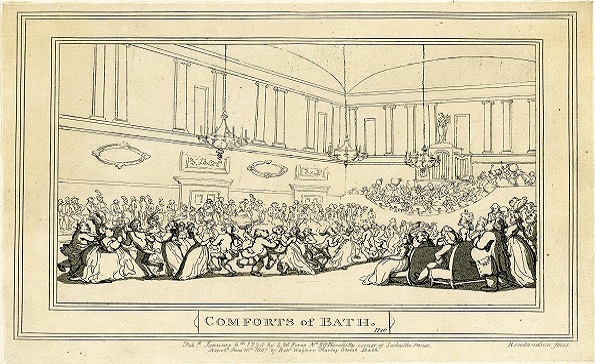
On 30th September 1771, the Upper Rooms in Bath opened their doors for the first time. Two hundred and fifty years later, the Bath 250 conference welcomed scholars from across the globe to celebrate this momentous occasion.
The conference pushed against a simple retelling of Bath’s glamorous spa town façade to uncover and present many of its hidden depths. In doing so, the papers collectively nuanced understandings of the operations and experiences of Bath in the eighteenth-century and beyond. This conference beautifully demonstrated the merits of utilising one space to examine a variety of different aspects of eighteenth-century society, to understand the multiplicities of experiences and create a fuller picture of how politics, health, entertainment, and polite society played out within one location.
The first day of the conference began with an opening keynote from Dr Hannah Greig, which introduced us to the centrality of the assembly rooms, not just within Bath, but towns and cities throughout the eighteenth century. Her talk wonderfully illustrated the role of the assembly rooms in cultivating ideas of sociability and as an accepted environment for the mingling of the sexes. Later talks considered some of the discomforts of sociability within these public spaces: the mixing of those pursuing entertainment with those seeking remedies, the anxieties of the marriage market and even how the proprieties of touch meant that the use of hands could be both dangerous but exciting.
Despite the Bath season occurring outside of the London parliamentary one, several talks stressed that Bath was not an escape from politics. Indeed, they presented politics as such a central aspect of Bath’s social scene that several speakers questioned exactly how restful it was for those there to recuperate from illness or to simply relax. Politics continued to play out via notions of sociability, through female influence and celebrity politicians.
The overlooked aspects of Bath’s social scene also threaded through the papers. Explorations of sedan chairmen and their struggles, the locations of lodging and boarding houses and the undertakers of Bath revealed social, political, and hierarchical elements of Bath society which co-existed amongst the more well-trodden histories of the balls, promenades, and pump room visits.
Yet Bath can foster more conversation over its overlooked or previously marginalised histories. In the roundtable session which examined the next 250 years of Bath’s history, Professor Olivette Otele called for a joining up of Bath’s decolonising and slavery projects to push this conversation forward and coordinate a response which looks to the future as well as the past. This prompted more general discussion from the panel on the need to present Bath as a place with multiple, concurrent narratives and the challenges of heritage sites to present this.
Various papers across both days focused on the Assembly rooms themselves, from the food and drink served, to the music performed, the country dances, and the competition to elect the Masters of Ceremony for the rooms. This included a consideration of life before the upper rooms and unexecuted assembly room plans. This led very nicely into the various discussions of the international influence and historical legacy of eighteenth-century Bath which brought the online section of the conference to a close.
The finale to the conference was a live event, set in the Upper Rooms themselves. Beginning proceedings was a keynote by Dr Jonathan Foyle which explored the architectural influences of the upper rooms. It was such a pleasure to gaze upon the plans, shapes and objects while spotting the little details in the rooms around us. After a wonderful introduction to the ridotto by Hillary Burlock, the conference ended with a spectacular dance display by the Bath Minuet Company which captured the essence of the activities of the Upper Rooms on that opening day in 1771. Long sets, cotillions and, of course, the minuet, rounded off what was a compelling two days of discussion and reflection on Bath and its history.
The organisers would like to acknowledge the generous sponsorship of the British Society for Eighteenth Century Studies and the Royal Historical Society, whose grants helped to support the attendance of PGRs and ECRs in Bath. They would also like to thank the Early Dance Circle, especially Barbara Segal, Bill Tuck, Sharon Butler and Paul Cooper, for their decision to award the Janet Hauton Grant to the conference. This helped to fund a sound engineer and Bath Minuet Company’s fantastic dance display which concluded the event. The event was also supported by the University of Liverpool, the History of Parliament, TORCH from the University of Oxford, Queen Mary University, London, and the National Trust, and special thanks goes to the technical team at the University of Liverpool for their exceptional work.
Rachel Bynoth
PGR, Bath Spa University/Cardiff University